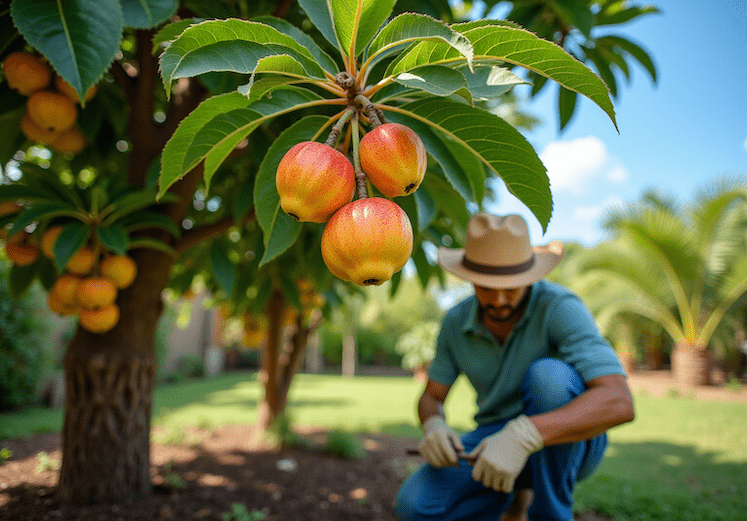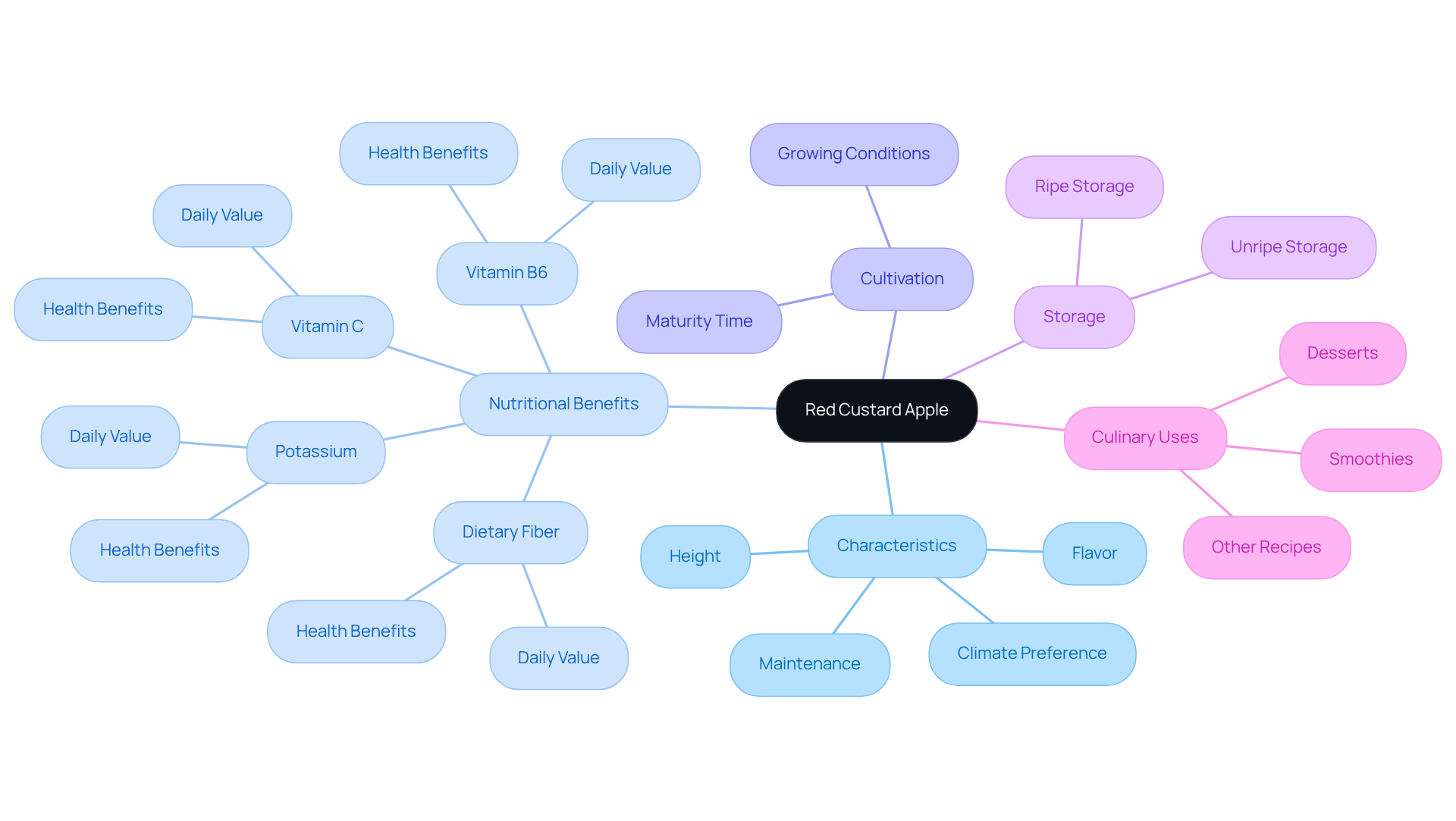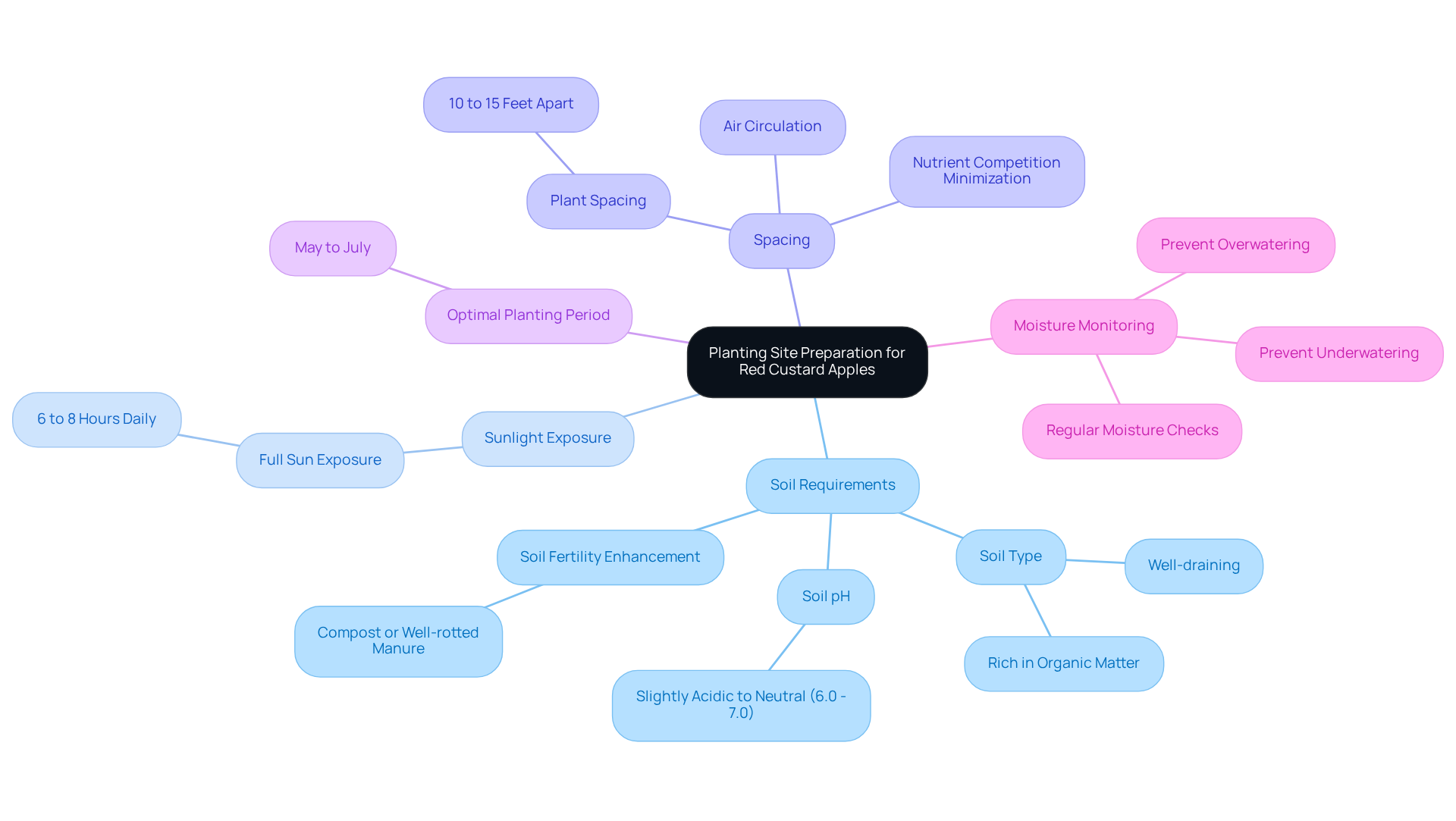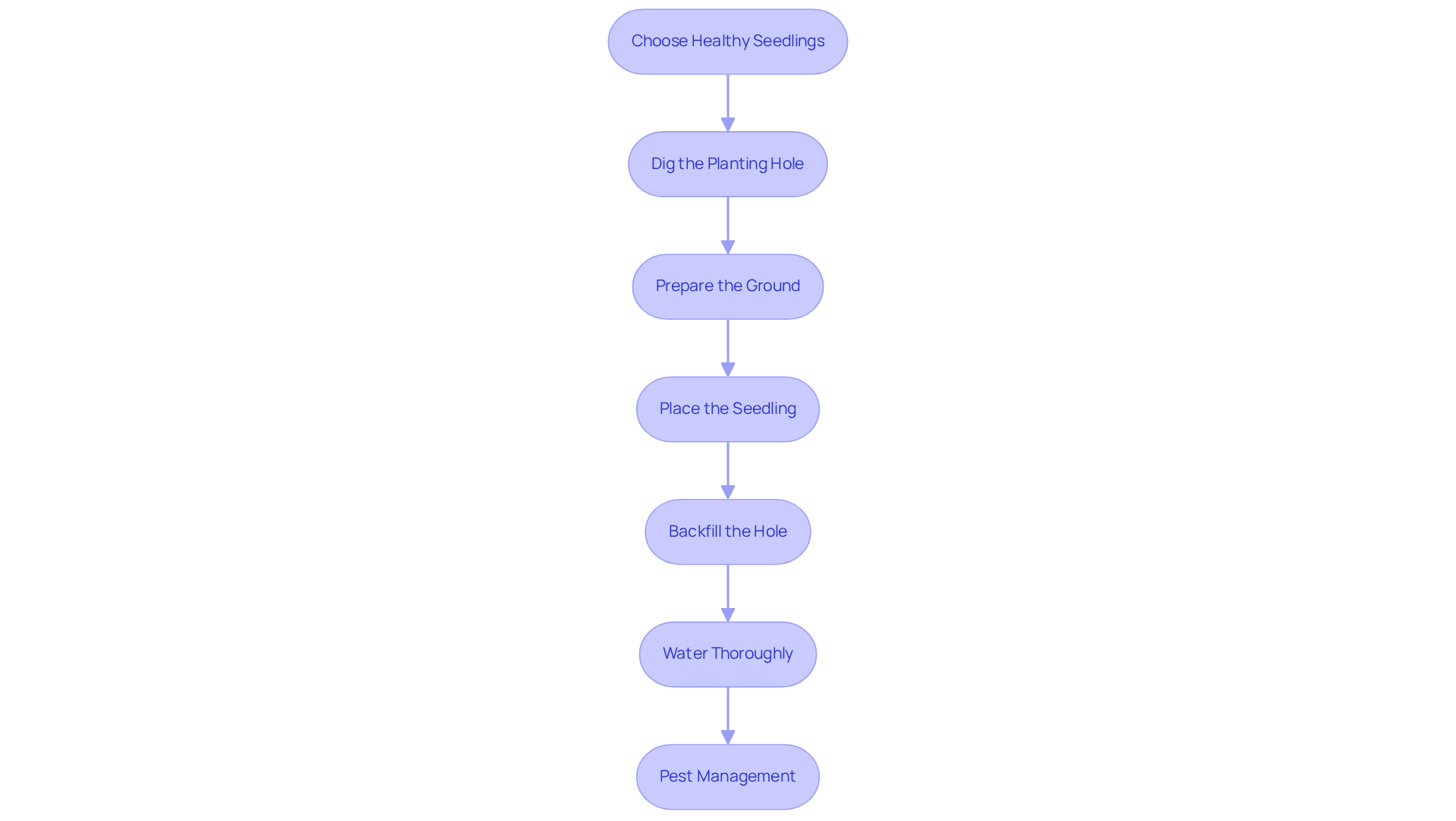
Grow Red Custard Apple: Step-by-Step Guide for Home Gardeners
Share
The Red Custard Apple captivates both seasoned gardeners and culinary enthusiasts with its sweet, creamy pulp, reminiscent of raspberry cheesecake. This tropical gem not only delights the palate but also offers numerous health benefits, including boosting immune function and aiding digestion. However, the journey from planting to harvest can be challenging, requiring careful attention to detail. To cultivate this unique fruit successfully, home gardeners must take essential steps and navigate potential pitfalls along the way.
Want to grow a Red Custard Apple Tree in your garden?
Explore Red Custard Apple Trees for sale at Everglades Farm - shipped directly from Florida.
Understand the Red Custard Apple: Characteristics and Benefits
The tropical plant known as the Red Custard Apple, or scientifically Annona reticulata, is renowned for its sweet, creamy pulp and unique flavor that resembles raspberry cheesecake. Typically, this plant grows to a height of 10 to 15 feet and thrives in warm, humid climates, making it a valuable addition to Everglades Farm's Fast-Growing Trees collection. Not only is its produce delicious, but it is also rich in nutrients, including:
- Vitamin C, which provides over 110% of the daily value per 100 grams
- Vitamin B6, which supports immune health and protein metabolism
- Potassium, essential for cardiovascular health
- Dietary fiber, which aids in digestion
With only 101 calories per 100 grams and minimal fat content, the red custard apple is a nutritious choice for any diet, accommodating various dietary preferences, including options that are vegan and gluten-free.
The tree's low-maintenance characteristics further enhance its appeal, enabling home gardeners to cultivate this tropical delight with ease. Notably, the red custard apple can also be cultivated in pots, providing versatility for those with limited gardening space. Regular consumption of this fruit may help reduce cholesterol levels, regulate blood glucose, and combat oxidative stress, contributing to overall well-being. However, it is crucial to be aware of the potential risks associated with high consumption of annonacin, a toxin present in custard apples.
For optimal storage, ripe custard apples should be consumed within 1-2 days at room temperature and can be refrigerated for 2-3 days. In contrast, unripe ones can be stored for 3-4 days at room temperature and up to 5-7 days in the refrigerator. The distinctive texture and flavor of this fruit also make it suitable for various culinary applications, including smoothies and desserts. Explore Everglades Farm's diverse offerings of tropical fruit trees, which include the red custard apple, and consider our professional-grade fertilizers to enhance your home gardening experience.

Prepare the Planting Site: Soil, Sunlight, and Spacing Requirements
To successfully cultivate a red custard apple, it is essential to choose a planting site that receives full sun exposure for at least 6 to 8 hours each day. The soil should be well-draining, rich in organic matter, and maintain a slightly acidic to neutral pH range of 6.0 to 7.0. Prior to planting, enhance soil fertility by incorporating compost or well-rotted manure, which aligns with the professional-grade fertilizers offered by Everglades Farm, including our organic compost blends designed to support healthy growth.
Ample space between plants is essential; ideally, they should be spaced 10 to 15 feet apart to accommodate their bushy growth habit. This spacing not only promotes sufficient air circulation but also minimizes competition for nutrients, fostering healthier growth and higher yields. The optimal planting period for custard apples is from May to July. Consistently monitor moisture levels to prevent overwatering or underwatering, as this is vital for the health of the red custard apple.
As Jonathan H. Crane, a tropical produce crop specialist, emphasizes, "Pay attention to the soil." Additionally, consider exploring Everglades Farm's Fast-Growing Trees collection, which features a variety of quick-yield tropical plants that can enhance your garden and improve your home gardening experience.

Plant the Red Custard Apple: Step-by-Step Planting Instructions
-
Choose Healthy Seedlings: Select a robust red custard apple seedling from a reputable nursery. Look for vibrant leaves and a sturdy stem, as these are indicators of a healthy plant. Experts emphasize that the quality of seedlings significantly impacts long-term growth and fruit production.
-
Dig the Planting Hole: Create a hole that is twice as wide and as deep as the ball of the seedling. This enables the underground structures to spread easily, promoting better establishment. Studies suggest that a shallow, broad planting hole promotes quick growth of the plant's system, which is vital for its health.
-
Prepare the Ground: Enhance the excavated earth by mixing it with compost to improve drainage and nutrient content. This practice not only aids in the growth of roots but also assists in avoiding waterlogging, which can be harmful to young plants. Sustaining equilibrium in amendment practices is crucial for fostering growth without forming obstacles that hinder plant establishment.
-
Place the Seedling: Position the seedling in the center of the hole, ensuring that the top of the ball is level with the surrounding earth. Proper ball depth is essential; the top 5-10% of the ball should be above grade to avoid issues like trunk-girdling growths, which can lead to tree decline.
-
Backfill the Hole: Fill the hole with the prepared earth mixture, gently pressing down to remove air pockets. This step is essential to guarantee proper contact with the plants, which assists in moisture retention and nutrient absorption.
-
Water Thoroughly: After planting, irrigate the plant deeply to assist in settling the ground around the roots. Maintain moist soil conditions without waterlogging for the first few weeks as the plant establishes itself. Effective watering practices are crucial for reducing transplant shock and promoting healthy growth.
-
Pest Management: Implement essential pest management practices to safeguard your Red Custard Apple plant. Consistently check for common pests and diseases that impact tropical fruit plants, such as aphids and fungal infections. Early detection and treatment can prevent significant damage and ensure a healthy harvest. This proactive method of pest control is essential for the successful establishment and growth of your plant.

Maintain Your Red Custard Apple: Watering, Fertilizing, and Pruning Tips
-
Regular irrigation is crucial for the health of the red custard apple plant, particularly during dry spells. Aim for thorough watering on a weekly basis, allowing the soil to dry slightly between irrigations to prevent root rot, a common issue for this delicate plant. In warmer months, you may need to increase the frequency to two to three times a week, particularly for younger plants.
-
Fertilizing: For optimal growth, apply a balanced fertilizer, such as a 10-10-10 formulation, every 6 to 8 weeks throughout the growing season. Organic options like compost or well-rotted manure can enhance soil fertility and improve overall plant health. It's essential to monitor the plant's response to fertilization; yellowing leaves may indicate a nutrient deficiency, while excessive growth could suggest over-fertilization.
-
Pruning: Annual trimming is vital for maintaining the form and health of the plant. Remove any dead or unhealthy branches and thin out overcrowded areas to improve air circulation and sunlight access, both of which are essential for producing crops. The best time to prune is during late winter or early spring, just before new growth begins, ensuring the plant is ready for a productive growing season.
Troubleshoot Common Issues: Pest Management and Weather Considerations
-
Effective pest management is vital for the healthy development and yield of red custard apple plants. Common pests such as mealybugs, fruit flies, and aphids can significantly impact plant vitality. Regular inspections are crucial for early detection of infestations. Employing organic insecticides, like neem oil, disrupts the feeding and reproductive systems of these pests, ensuring effective control. Additionally, introducing beneficial insects, such as ladybugs, can naturally regulate pest populations, promoting a balanced ecosystem in your garden. For optimal results, neem oil should be applied consistently on a weekly basis, while Pyganic, an OMRI listed botanical insecticide, can be utilized throughout the growing season.
-
Weather considerations significantly influence the health of red custard apple plants. These plants are sensitive to extreme conditions, making protective measures essential. To safeguard young plants from frost, cover them with cloth or relocate potted plants indoors during cold snaps. During hot, dry spells, consistent watering is vital to prevent stress and maintain vigor. In the event of heavy rains, mulching around the base can improve drainage and reduce the risk of root rot, thereby protecting your trees from adverse weather effects.
Conclusion
The journey of cultivating the Red Custard Apple, or Annona reticulata, is not just rewarding; it significantly enriches the home garden with its delicious, nutrient-rich fruit. This guide has illuminated the essential steps and considerations for successful cultivation, from understanding the plant's characteristics and benefits to the meticulous care required for planting, maintenance, and pest management.
Key insights include:
- The importance of selecting healthy seedlings
- Ensuring proper soil conditions
- Adhering to watering and fertilization schedules
Additionally, maintaining vigilance against pests and weather extremes is crucial for fostering a thriving red custard apple plant. By following these guidelines, home gardeners can enjoy the sweet rewards of their labor while contributing to their health through this nutritious fruit.
Embracing the cultivation of the Red Custard Apple not only enhances one’s gardening skills but also promotes a deeper appreciation for the benefits of growing one’s own food. As the world increasingly leans towards sustainable living, investing time and effort into growing this tropical delight can yield both personal satisfaction and health benefits. Start your gardening adventure today and experience the joy of harvesting your very own red custard apples.
Grow Your Own Red Custard Apples Today!
Start your gardening adventure with Everglades Farm and savor the taste of home-grown nutrition.
Frequently Asked Questions
What is the Red Custard Apple and what are its characteristics?
The Red Custard Apple, scientifically known as Annona reticulata, is a tropical plant recognized for its sweet, creamy pulp and unique flavor that resembles raspberry cheesecake. It typically grows to a height of 10 to 15 feet and thrives in warm, humid climates.
What nutritional benefits does the Red Custard Apple offer?
The Red Custard Apple is rich in nutrients, including over 110% of the daily value of Vitamin C per 100 grams, Vitamin B6, potassium, and dietary fiber. It contains only 101 calories per 100 grams and minimal fat, making it a nutritious option for various diets, including vegan and gluten-free.
How does the Red Custard Apple contribute to health?
Regular consumption of the Red Custard Apple may help reduce cholesterol levels, regulate blood glucose, and combat oxidative stress, contributing to overall well-being. However, it is important to be cautious of high consumption due to the presence of annonacin, a toxin in custard apples.
What are the storage recommendations for Red Custard Apples?
Ripe custard apples should be consumed within 1-2 days at room temperature and can be refrigerated for 2-3 days. Unripe custard apples can be stored for 3-4 days at room temperature and up to 5-7 days in the refrigerator.
What are the planting requirements for a Red Custard Apple tree?
The Red Custard Apple tree requires full sun exposure for at least 6 to 8 hours daily, well-draining soil rich in organic matter, and a slightly acidic to neutral pH range of 6.0 to 7.0.
How should the planting site be prepared for the Red Custard Apple?
Prior to planting, enhance soil fertility by incorporating compost or well-rotted manure. Ensure that plants are spaced 10 to 15 feet apart to promote air circulation and minimize competition for nutrients.
When is the optimal planting period for Red Custard Apples?
The optimal planting period for Red Custard Apples is from May to July.
What care should be taken regarding moisture levels for Red Custard Apple trees?
It is vital to consistently monitor moisture levels to prevent overwatering or underwatering, as this is essential for the health of the Red Custard Apple tree.


